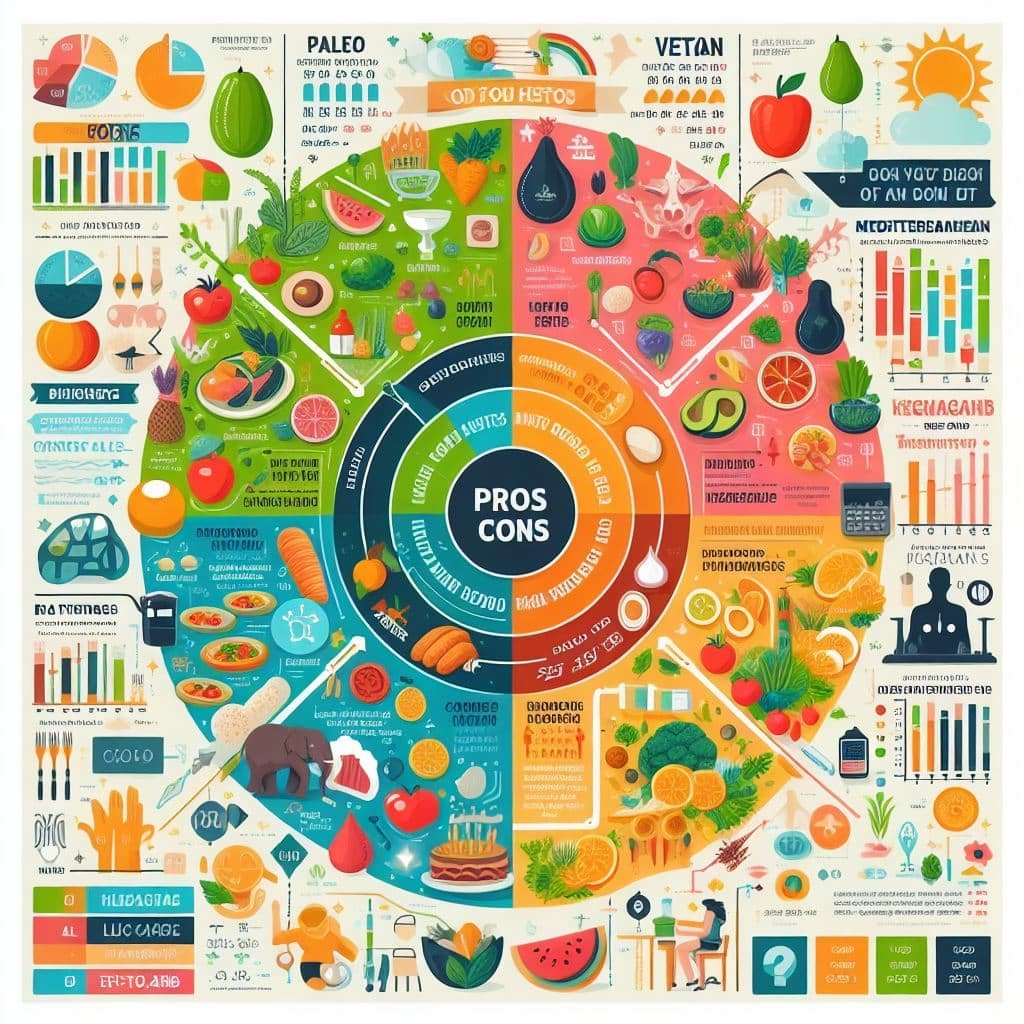
Diet is a term that refers to the way a person eats, usually to improve their health, weight, or performance. There are many types, each with its benefits and drawbacks. Some Eating plan are based on scientific evidence, while others are based on personal beliefs, preferences, or traditions. In this article, we will explore some of the most popular types of diets and how they compare.
Table of Contents
Intermittent Fasting Diet
Intermittent Fasting is an eating pattern characterized by alternating periods of eating and fasting. It doesn’t focus on specific food choices but emphasizes when you eat. Common methods include the 16/8 method (16 hours fasting, 8 hours eating) or periodic whole-day fasts. Advocates suggest potential benefits for weight management, metabolism, and overall health.
- Fasting Phases: Alternating periods of eating and fasting.
- Food Timing Focus: Emphasizes when to eat rather than specific food choices.
- 16/8 Method Beam: 16-hour fasting window, 8-hour eating period.
- Potential Benefits Beam: Weight management, improved metabolism, and health enhancements.
- Adaptability Beam: Flexible schedules for personalized wellness.
Intermittent fasting weaves these beams into a pattern of controlled eating cycles, offering a flexible and potentially beneficial approach to overall well-being.
Mediterranean Diet
Rooted in Mediterranean culinary traditions, this program thrives on fresh fruits, veggies, whole grains, and the golden touch of olive oil. Featuring fish, poultry, and a sprinkle of herbs, it champions lean delights. With a nod to moderation and the occasional red wine, this program encapsulates a delicious prescription for heart health and vitality.
- Colorful Produce: Abundance of fruits and vegetables for essential nutrients.
- Olive Oil Essence: Monounsaturated richness supporting heart health.
- Seafood Harmony: Omega-3 from fish for cardiovascular well-being.
- Whole Grain Foundations: Wholesome grains for sustained energy.
- Legume Power: Plant-based proteins and fiber for balance.
- Herbs and Spice Elevation: Flavor infusion without excess salt.
- Culinary Moderation: Balanced portions and mindful eating.
- Social Dining Tradition: Shared meals for social connection and joy.
The Mediterranean seamlessly weaves these elements into a nutritional tapestry, promoting health and well-being.
Ketogenic Diet
A low-carb, high-fat eating plan, the Ketogenic aims to trigger ketosis, prioritizing fat as the primary energy source. Advocates suggest benefits for weight loss and mental clarity, emphasizing fats from sources like avocados and nuts while limiting carbohydrates.

- Ketosis Core: The central beam of the ketogenic, inducing a metabolic state where the body prioritizes burning fat for energy.
- Low-Carb Focus Beam: Restricting the intake of carbohydrates is a foundational beam, guiding followers towards minimal carb consumption.
- High-Fat Embrace: A key beam emphasizing the consumption of healthy fats from sources like avocados, nuts, and oils, providing sustained energy.
- Moderate Protein Support Beam: Balancing macronutrients, the meal plan encourages a moderate intake of proteins, ensuring muscle support without compromising ketosis.
- Weight Loss Pillar: Advocates highlight the weight loss beam, suggesting that ketogenic may lead to effective fat burning and reduced body weight.
In the framework of the ketogenic, these beams converge to create a nutritional strategy centered on fat-focused fuel, potentially offering a unique approach to wellness and weight management.
Vegan Diet
Vegan is a plant-based eating pattern that abstains from all animal products, including meat, dairy, and eggs. Rooted in ethical and environmental principles, this program focuses on fruits, vegetables, nuts, seeds, and grains, offering a cruelty-free and sustainable approach to nutrition. Followers embrace the benefits of a plant-centric lifestyle, promoting health, compassion, and a reduced ecological footprint.
- Plant-Exclusive Core: The central beam of the vegan is an exclusive reliance on plant-derived foods, eschewing all animal products for a cruelty-free lifestyle.
- Colorful Produce Beam: A vibrant beam highlighting the abundance of fruits and vegetables, providing essential vitamins, minerals, and antioxidants.
- Nut and Seed Support Beam: Emphasizing the consumption of nuts and seeds as crucial beams, offering plant-based proteins, healthy fats, and essential nutrients.
- Grains and Legume Pillars: The foundational beams of grains and legumes contribute to a well-rounded and protein-rich plant-based diet.
- Ethical and Environmental Focus: The overarching beam highlights the diet’s commitment to ethical treatment of animals and environmental sustainability.
In the vegan framework, these beams unite to create a lifestyle that not only nourishes the body with plant-powered goodness but also aligns with principles of compassion and eco-conscious living.
Paleolithic Diet (Paleo)
The Paleolithic mirrors the eating habits of our ancient ancestors, emphasizing whole foods like lean meats, fish, fruits, vegetables, nuts, and seeds while excluding processed items. Rooted in aligning with our genetic heritage, this program promotes health through nutrient-dense, unprocessed choices, reflecting a return to primal eating habits.
- Primal Protein Focus: The foundational beam of lean meats and fish, echoing the primary protein sources of our ancient ancestors.
- Fruits and Vegetable Pillars: A robust beam emphasizing the intake of fruits and vegetables, mirroring the plant-rich diet of the Paleolithic era.
- Nut and Seed Supports: Vital beams highlighting nuts and seeds, providing essential fats and nutrients in line with ancestral foraging.
- Grain and Dairy Exclusion Beam: A distinctive beam excluding grains and dairy, aligning with the Paleolithic avoidance of agricultural products.
- Unprocessed Philosophy: The overarching beam, emphasizing a return to unprocessed, whole foods in sync with the diet’s ancestral roots.
In the Paleolithic, the focus on primal protein, abundant plants, and the exclusion of certain modern foods created a nutritional framework designed to harmonize with our evolutionary past.
DASH Diet (Dietary Approaches to Stop Hypertension)
The DASH, or Dietary Approaches to Stop Hypertension, is a heart-healthy eating plan. Focused on fruits, vegetables, lean proteins, and low-fat dairy, it aims to lower blood pressure by reducing sodium and unhealthy fats. Beyond hypertension control, it offers broader cardiovascular and weight management benefits.
- Fruits and Veggie Pillars: A foundational beam highlighting an abundant intake of fruits and vegetables, rich in essential vitamins and antioxidants.
- Lean Protein Focus Beam: A crucial beam emphasizing the inclusion of lean proteins, supporting muscle health and satiety.
- Dairy Moderation Beam: A beam emphasizing low-fat dairy, contributing to calcium intake without excess saturated fats.
- Whole Grain Support Beam: A vital beam encouraging the consumption of whole grains, offering fiber and essential nutrients.
- Sodium Reduction Pillar: A distinct beam targeting the reduction of sodium, a key strategy for blood pressure control.
- Heart-Healthy Fats Embrace The overarching beam promotes heart-healthy fats, encouraging choices like nuts, seeds, and olive oil.
In the DASH, a symphony of heart-healthy choices comes together, creating a nutritional masterpiece designed to support cardiovascular health and overall well-being.
Flexitarian Diet
The Flexitarian, a portmanteau of “flexible” and “vegetarian,” is a predominantly plant-based eating style with occasional inclusion of meat or fish. It offers flexibility, allowing individuals to enjoy the health benefits of a plant-centric diet while occasionally incorporating animal products. The focus is on whole, unprocessed foods, encouraging a mindful and balanced approach to nutrition. This flexible and inclusive dietary strategy promotes both personal well-being and sustainability.
- Plant-First Foundation Beam: The central beam emphasizes a predominantly plant-based diet rich in fruits, vegetables, legumes, and whole grains.
- Flexibility Support Beam: A vital beam allowing the occasional inclusion of meat or fish, offering flexibility without strict dietary constraints.
- Whole Foods Pillar: A foundational beam advocating for the consumption of whole, unprocessed foods, promoting nutrient density and overall well-being.
- Mindful Eating Beam: A crucial beam encouraging mindful and conscious eating, fostering a balanced and intentional approach to nutrition.
- Sustainability Embrace: The overarching beam promoting sustainability, as a flexitarian diet aligns with reduced environmental impact through plant-centric choices.
In Flexitarian, the focus on plant-forward flexibility and mindful eating creates a nutritional framework that not only supports personal health but also aligns with a sustainable and adaptable lifestyle.
Zone Diet
The Zone, crafted by Dr. Barry Sears, focuses on precise macronutrient balance in every meal. With a 40-30-30 ratio of carbohydrates, proteins, and fats, it aims to optimize hormonal balance for weight management and overall health. Portion control is key, promoting stable blood sugar levels and a sense of well-being.
- 40-30-30 Core Beam: The central beam, orchestrates a specific balance of 40% carbohydrates, 30% protein, and 30% fats for hormonal equilibrium.
- Precision Portion Pillar: A crucial beam emphasizing portion control, ensuring meticulous balance in each meal for stable blood sugar levels.
- Carb-Protein-Fat Synchronization: The foundational beam syncing carbohydrates, proteins, and fats, aiming to optimize metabolic and hormonal functions.
- Well-Being Embrace Beam: An overarching beam promoting a sense of well-being, as the Zone precise balance supports weight management and overall health.
In the Zone, the focus on macronutrient precision and portion control creates a nutritional framework designed to harmonize metabolic functions and foster holistic well-being.
Carnivore Diet
The Carnivore is an exclusive eating plan centered around animal products, primarily meat. Advocates believe in its alignment with ancestral habits, potentially offering weight loss and mental clarity benefits. However, its strict exclusion of plant-based foods raises concerns about nutritional balance and long-term health risks.

- Exclusive Meat Focus Beam: The central beam, advocating for the exclusive consumption of meat and animal products as the primary source of nourishment.
- Ancestral Alignment Pillar: A foundational beam rooted in the belief that the meal plan mirrors the dietary habits of our ancestors, promoting a return to primal eating patterns.
- Weight and Clarity Benefits Beam: An emphasized beam suggesting potential benefits, including weight loss and improved mental clarity, associated with an all-meat meal plan.
- Nutritional Controversy Beam: A distinct beam acknowledging controversy, as the diet raises concerns about nutritional imbalances and potential long-term health risks.
In the Carnivore, the focus on exclusive meat consumption and ancestral alignment creates a unique nutritional approach, marked by potential benefits and contentious debates.
Blood Type Diet
The Blood Type tailors dietary recommendations to an individual’s blood type (A, B, AB, or O), aiming to optimize health by aligning food choices with specific blood types. Advocates claim it enhances digestion and overall well-being, though scientific support remains controversial.
- Blood Type Specificity Beam: The central beam, tailoring dietary recommendations to individual blood types (A, B, AB, O) for personalized nutrition.
- Health Optimization Pillar: A foundational beam suggesting that aligning with one’s blood type enhances digestion and overall well-being.
- Controversy Awareness Beam: A distinct beam acknowledging the controversial nature of the diet within the scientific community, where evidence supporting its claims remains a topic of debate.
In Blood Type, the focus on personalized nutrition and potential health optimization creates a framework that invites both interest and skepticism.
Final Thoughts
Choosing the right diet is a highly personal decision influenced by various factors, including health goals, preferences, and individual responses to specific foods. It’s essential to approach any diet change with a well-informed perspective, considering long-term sustainability and overall well-being.
Before embarking on any significant dietary shift, consulting with a healthcare professional, nutritionist, or dietitian is highly recommended. They can provide personalized advice based on your health status, ensuring that your dietary choices align with your overall health objectives.
Remember, while diets play a crucial role in health, they are just one aspect of a broader lifestyle that includes regular physical activity, sufficient hydration, and adequate sleep. Striving for balance, moderation, and consistency in your overall lifestyle will contribute significantly to your health and well-being over the long term.




[…] a meal plan for kidney disease needs careful thought. You must think about your dietary needs, favorite foods, and how to cook […]